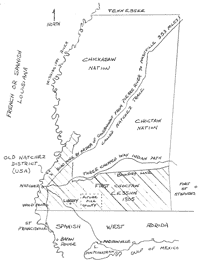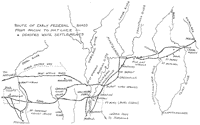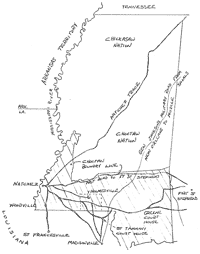 Roads to Mississippi Territory before 1805 04-1 (Click to enlarge) |
 Early Feferal Roads between Macon and Natchez 04-2 (Click to enlarge) |
 Roads to Mississippi Territory, 1819 04-3 (Click to enlarge) |
|
|
|
|
|
Summary: The journey to Mississippi Territory was made over poorly-marked footpaths through Indian-occupied territory during the winter months. River crossings were especially troublesome. Samuel Varnadoe and his family made the journey in 1811. Richard and Ann Simmons followed in 1812.
Samual Varnadoe heads west
There is little in the family traditions about the journey from South Carolina. We know when Samuel Varnadoe made the journey because until 1830, when Congress passed a bill abolishing the Indian nations east of the Mississippi River, the Choctaw and Creek Nations were technically foreign countries. When the US government recognized these so-called Civilized Indian Nations in 1786 it assumed the responsibility of regulating those American citizens living or traveling in the Indian nations. US citizens traveling to Mississippi Territory from the eastern states were required to have passports. The Varnadoes obtained their passports from a judge in Jones County, Georgia. The two elder sons of Samuel Sr. held passports issued in October 1809. A younger son, who accompanied his father to Mississippi, got a passport in March 1810. A year later Samuel Sr. was issued a passport for himself, his wife, his seven children and two slaves. Samuel's group followed the others to Mississippi in the spring of 1811.
I have no knowledge of the route they took to get to Mississippi. However there were very few roads into the Mississippi Territory in those days so it is possible to make a reasonable guess. The very earliest settlers from both the Carolinas and Georgia came down the Cumberland River on rafts, got onto the Mississippi River and floated down to the village of Natchez. From there they walked the remaining sixty or seventy miles to what became Amite and Pike Counties.
Later settlers from Georgia would begin their journey on the Federal Road that originated in Macon, Georgia. This road ran past where the cities of Columbus and Montgomery are today and then turned southwest to New Orleans. Close to what was later Fort Claiborne, at a place called Burnt Corn Springs, a wagon road called the Three-Chopped Way branched off to Natchez. This trail roughly paralleled the present US Highway 84. After ferrying the Alabama River at Fort Claiborne about 65 miles north of Mobile the road proceeded to Fort St. Stephens on the Tombigbee River, a distance of 25 miles. From Fort St. Stephens the road ran westerly for 150 miles until it crossed the Pearl River near where Monticello, Mississippi, is today. After having ferried the Pearl River, settlers aiming for the region of Pike County could leave the Three-Chopped Way and walk in a southwesterly direction. The only major stream that would have to be crossed in that direction was the Bogue Chitto.
Since there were no wagon roads leading south from the Three-Chopped Way in that immediate area travelers with wagons might choose to stay on the main trail for another 50 or 60 miles. A few miles east of Natchez the Natchez to Mobile Trace joined the Three-Chopped Way. The Natchez to Mobile Trace passed through the site of Liberty and then crossed Pike County. It is possible that some of our ancestors took this route, traveling nearly to Natchez on the wagon road before turning southeast on the Natchez to Mobile Trace until they arrived in the region of Osyka. We do know that some families came to Pike County in ox wagons by way of Natchez. Prior to 1819 there were no other possible routes.
By 1819 a road had been cut from St. Francisville on the Mississippi River to St. Tammany Courthouse and then to Madisonville on Lake Ponchetrane. A spur from the road ran north through what is now Pike County to Holmesville . This road intersected the Three-Chopped Way a few miles north of Holmesville in the Choctaw Nation. To my knowledge when the Varnadoes and the Simmons came from Georgia, this alternate route for wagons did not exist. The Simmons, at least, apparently did not travel by wagon.
In those early days the wagon roads were barely more than footpaths. No improvements were attempted outside of what the users themselves made. There were no bridges and so fording rivers and streams was a dangerous and eventful part of the journey to Mississippi. The crossing of streams are memorialized by both the Samuel Varnadoe and the Richard Simmons families. Varnadoe family tradition says that Pearl Varnado, the first child of Samuel Sr. by his second wife, was born while the family waited for the swollen Pearl River to subside in the spring of 1811. We know what happened to the Simmons family because a grand-son of Richard Simmons wrote an article entitled "The Providence of God." In the article the author used the event of his grand-parents attempt to cross a rain-swollen river to illustrate the point that we live because of the kindness of God. Hansford Simmons reprinted the article in his book and I have copied part of it here.
"In the month of February AD 1812, there was a family moving from South Carolina to a point in the Mississippi Territory, near where Osyka now stands. They had to cross the Bogue Chitto about eight miles below where Holmesville now stands at a ford near A.W. Loves. The river being somewhat swollen, there was put in a large wagon. A white lady and five of her smallest children consisting of three little boys aged 6-5-4, and two little girls aged two and an infant, one girl of the age of 14, one Negro woman, three little children of the driver of the wagon. A colored man happening to be in the company at the time, professed to be acquainted with the ford, by some mismanagement turned the horses too square across the stream. They soon turned down the river and away all went down stream for some distance when to the surprise of all present the wagon stopped. By this time the horses were beyond their depth and were all frequently under water, when to the joy of all present the wagon stopped. Men swam in and contrived to rescue all the jeopardized and landed them back on the shore on the side they started from. No one was injured except the driver badly ducked and strangled in the water. In a few days they reached the place of their destination, settled four miles east of where Osyka now stands."
The reader might have noticed that the author of the article, W.W. Simmons, does not say that the family was traveling by wagon. On the contrary he states that they attempted to cross the stream in a wagon only because the water was too high to wade across. Furthermore it is clear that the wagon belonged to someone else. It is certain then that the family of Richard Simmons left the Three-Chopped Way just to the north of Pike County and walked almost directly south to near Osyka. They had probably walked all the way from South Carolina, pulling their few possessions on an ox-drawn sled upon which the babies could ride. If the sled had no metal runners then the family would stop every few days and Richard would fashion new skids from trees growing by the side of the trail.
I do not have similar information about the family of Samuel Varnadoe which had made the same journey just months before. It is reasonable to assume that they traveled in the same way. In a book published in 1986 Louis G. Varnado, who was born in 1874, gives the following account of his great-grandfather's arrival in Mississippi.
"My great-grandfather joined a caravan going west and they had to build rafts to cross the rivers. When they held up at Pearl River below Columbia, my grandfather was born. There was a lone white man who had settled out from the river on the Indian trail that the caravan was following. He came down to meet his fellows and his name was White.
He insisted that great-grandmother be carried up to his house and kept until she was able to travel. When she was able to go, the caravan had been gone for several days. They tried to follow the trail but failed, and stopped at Osyka, or rather, where Osyka now is. There he raised his family."
This account probably is nearly true. The first house on the Pearl River in this region was built between 1805 and 1809 on a plateau about a mile from the river. It was the home of John Ford, a Methodist minister who later helped organize the State of Mississippi. It may seem strange to us that the journey was made in February. However for farmers December, January and February were the only months of the year during which they were not planting, caring for or harvesting a crop. They had probably left Georgia or South Carolina after Christmas, traveled all of January and arrived in Mississippi Territory in early February. This would give them just enough time to prepare ground for a planting in March.
Back to Table of Contents | Chapter 5
Copyright © 1994-2005 by Philip Mullins. Permission is granted to reproduce and transmit contents for not-for-profit purposes.